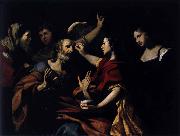La Peinture à l'huile en gros de Chine & Encadre |
|||||||||||

|
|||||||||||
|
|
|
||||||||||||||
|
Jacques Blanchard
(1600 - 1638), also known as Jacques Blanchart, was a French baroque painter who was born in Paris. He was raised and taught by his uncle, the painter Nicolas Bollery (ca. 1560-1630). Jacques's brother and son, Jean-Baptiste Blanchard (after 1602-1665) and Gabriel Blanchard (1630-1704), respectively were also painters. Jacques spent the years from 1624 to 1628 studying in Bologna and Venice. After briefly working in Turin at the court of the Charles Emmanuel I, Duke of Savoy (ca. 1628) he returned to France and set himself up in Paris in 1629. Jacques Blanchard is best known for his small religious and mythological paintings. He died in Paris in 1638. This painter should not be confused with the French sculptor of the same name who lived from 1634 to 1689. Nothing seems to be known of his work before he left for Rome at the age of twenty-four. After two years he moved to Venice, where he remained for two more years. It was there that his style was formed. He then went to Turin, where he worked for the Dukes of Savoy, before returning to France 1628. It is from the brief but productive period after his return that all his dated works survive. They show him to stand quite apart from his contemporaries, not only in his painting style but also in his choice of sensual subject-matter, for example the Bacchanal at Nancy. The chief influences were the sixteenth century painters, especially Titian and Tintoretto with their rich, warm colours, and Veronese, whose blond and silvery colour and limpid light he used most effectively in his small religious and mythological subjects. The several versions of Charity, depicted as a young woman with two or three children, are excellent examples of his tenderness of colour handling, and of a softness of sentiment nearer to the 18th than to the 17th century. |
||||||||||||||
|
|
||||||||||||||
|
||||||||||||||
|
|
||||||||||||||
| Jacques Blanchard
(1600 - 1638), also known as Jacques Blanchart, was a French baroque painter who was born in Paris. He was raised and taught by his uncle, the painter Nicolas Bollery (ca. 1560-1630). Jacques's brother and son, Jean-Baptiste Blanchard (after 1602-1665) and Gabriel Blanchard (1630-1704), respectively were also painters. Jacques spent the years from 1624 to 1628 studying in Bologna and Venice. After briefly working in Turin at the court of the Charles Emmanuel I, Duke of Savoy (ca. 1628) he returned to France and set himself up in Paris in 1629. Jacques Blanchard is best known for his small religious and mythological paintings. He died in Paris in 1638. This painter should not be confused with the French sculptor of the same name who lived from 1634 to 1689. Nothing seems to be known of his work before he left for Rome at the age of twenty-four. After two years he moved to Venice, where he remained for two more years. It was there that his style was formed. He then went to Turin, where he worked for the Dukes of Savoy, before returning to France 1628. It is from the brief but productive period after his return that all his dated works survive. They show him to stand quite apart from his contemporaries, not only in his painting style but also in his choice of sensual subject-matter, for example the Bacchanal at Nancy. The chief influences were the sixteenth century painters, especially Titian and Tintoretto with their rich, warm colours, and Veronese, whose blond and silvery colour and limpid light he used most effectively in his small religious and mythological subjects. The several versions of Charity, depicted as a young woman with two or three children, are excellent examples of his tenderness of colour handling, and of a softness of sentiment nearer to the 18th than to the 17th century. Tobias_Healing_the_Blindness_of_His_Father first half of 17th century Medium oil on canvas cyf first half of 17th century Medium oil on canvas cyf |
||||||||||||||
|
Related Paintings to Jacques Blanchard :. |
||||||||||||||
|
|
||||||||||||||
|
|
||||||||||||||
|
CONTACTER DES Etats-Unis |







